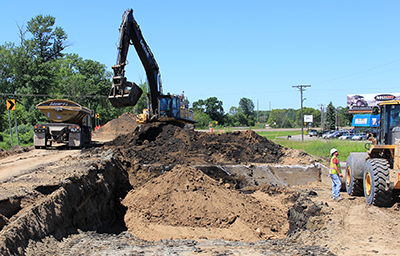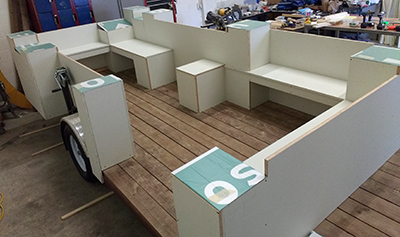 |
|

|
 |
TABLE of CONTENTS
|
RTMC expanding to statewide coverage |
By Sue Roe

Tom Shields, RTMC dispatcher, monitors traffic incidents and maintenance operations from the Regional Traffic Management Center. Shields uses information imported from MnDOTís and State Patrolís computer aided dispatch and 511 entries to change dynamic message signs to tell the public about incidents and road maintenance and construction that results in reduced speeds, lane reductions, detours, etc. Photo by Sue Roe |
The Regional Transportation Management Center began the process of expanding its operations statewide during the summer, taking over the greater Minnesota coverage from the State Patrol.
MnDOT previously covered the seven-county Twin Cities Metro area while the State Patrol covered greater Minnesota.
“We are slowly rolling out our coverage as we get our new equipment,” said Garret Schreiner, freeway operations engineer at the RTMC. “We started with two districts and will ease into expanding it into the other districts.”
State Patrol, MnDOT Metro maintenance and MnDOT traffic operations dispatchers work out of the RTMC to detect, respond to and remove traffic incidents off the freeway systems. Traffic operations also include management of lane control signals, ramp meters and dynamic message signs. Maintenance operations include lane closures and reductions and detours. The 511 traveler information system also operates out of the RTMC.
Monitoring traffic incidents and operations is already available statewide. Construction, 511 and maintenance operations were initially expanded into Districts 2 and 4.
Two full-time and two part-time employees were hired to expand the RTMC operations. Two dispatchers will work the 5 a.m. to 9 p.m. shifts during weekdays and two dispatchers will work during the weekend.
“We’ll gain greater consistency statewide with real-time traffic incidents and construction and maintenance operations,” said Schreiner. “We worked with State Patrol to make this happen. As we add more traffic cameras and other traffic operation devices in Greater Minnesota, we recognized that it would be more for State Patrol to manage and it’s not their top priority.”
Districts will be able to relay information to the RTMC such as lane closures and detours, which will be entered into 511. Traffic incident information can also be imported into systems, which will alert RTMC dispatchers to change dynamic messaging signs throughout the state. Districts will still have the capability of changing their own signs.
Schreiner said the statewide coverage will allow dispatchers to monitor all state, county and some city roads.
One of the technologies being added is GPS-speed data devices to see where traffic slowdowns are occurring. The GPS technology was used on Metro roads, but will replace physical devices on Greater Minnesota roadways.
“We anticipate to really see the benefits of this expanded coverage this winter,” said Schreiner. “The public will see more up-to-date and detailed information than before on 511 and our message signs.” |
 |
|

|
 |
TABLE of CONTENTS
 |
Communications and contracting combine to deliver successful project |
By JP Gillach, District 3 public affairs coordinator

Hwy 55 between Buffalo and Rockford underwent a partial rebuild this summer. Photo by JP Gillach |
In fall 2017, District 3 upgraded a mill and overlay project on Hwy 55 between Buffalo and Rockford, to a partial rebuild, with major underground pipe and box culvert replacements and other improvements. The major change in scope also meant a major increase in traffic impacts, as the traffic plan moved from overnight single lane closures, to closing all lanes of Hwy 55 between Buffalo and Rockford for several weeks.
To complicate matters, Hwy 55 between Buffalo and Rockford in Wright County is District 3’s highest volume two-lane road. With the latest traffic counts showing more than 19,000 trips per day on a road that creates commuter and commerce connections between Wright County and the Twin Cities Metro Area, traffic and business impacts instantly became one of the project’s largest risks.
To help mitigate the duration of the required detour, the contract included a combination of A+B contracting (cost plus time bidding) and incentives to minimize the detour duration.
“The idea was to get in, get it done, get out, and allow the contractor to do a good job,” said Cal Puttbrese, District 3 assistant district engineer, construction.

Crews resurface Hwy 55 between Buffalo and Rockford. The project was completed Aug. 29. Photo by JP Gillach |
When the competitive bids were opened, every contractor bid to have the road closed for no more than 44 days.
With construction approach decided, focus moved to a strategic communications plan to help mitigate the impacts. The plan included a combination of engagement and outreach, customer research, communications and customer service tactics.
In the end, the contractor opened the road after only 40 days, earning an incentive for each day the road opened early. Complaints were minimal, especially when compared to what was expected. And overall feedback from businesses and the business community has been positive.
Feedback from traveling public was very positive.
“I want to let everyone at MNDOT that my husband and I are very happy with our new Hwy 55 from Rockford to Division St in Buffalo,” said a local motorist in an email. “The time that we were not able to drive on it went by fast, actually. Your office did a wonderful job of keeping us informed via e-mail. The road is so smooth and I thank you for the left turn lane at 55 and Walnut St., the entrance to the mall. Please let everyone know who was in charge of this project, that is was a job well done. All of their hard work is appreciated by us. Thank You” |
 |
|

|
|

|
|

|
 |
TABLE of CONTENTS
 |
Tim Sexton is named Chief Sustainability Officer |

Tim Sexton is MnDOTís Chief Sustainability Officer. Photo by Rich Kemp |
Tim Sexton took over as MnDOT’s first Chief Sustainability Officer Sept.19. He is assigned to the Commissioner’s staff and provides executive leadership and oversight of agency sustainability programs that help the agency explore and adopt new ways to reduce environmental impact and adapt to the changing climate.
“In his new role, Tim will work closely with senior leadership and key partners and stakeholders both inside and outside the agency to champion long-term, cost-effective investments for improved energy efficiency, renewable energy, transportation electrification and resource conservation,” said Commissioner Charlie Zelle.
Sexton joined MnDOT as an assistant director in the Office of Environmental Stewardship in 2014, where he directed the Construction and Operations Section, which includes blowing and drifting snow control, roadside vegetation management, environmental investigation, environmental modeling and testing and the erosion control and storm water management units. He also chairs the agency Sustainable Transportation Steering Committee and has completed a mobility as director of the Office of Transit and Active Transportation.
Before coming to MnDOT, Sexton managed climate policy at the Washington State DOT, built green/vegetated roofs in Germany and founded a land-use planning firm in Iowa. He attended the University of Iowa where he earned a bachelor of arts degree in anthropology, certificate in international business, master of science degree in urban and regional planning, and master of public health degree in environmental health. |
 |
|

|
 |
TABLE of CONTENTS
 |
Several agency staff move to fill leadership mobilities |
By Mary McFarland Brooks

Ed Idzorek, Office of Transportation System Management Photo by Rich Kemp |
Ed Idzorek, Mike Ginnaty, Jon Solberg and Amber Blanchard have accepted six month mobility assignments created by the vacating of some key office director positions.
Idzorek is the office director for Transportation System Management. He previously served as the Portfolio Manager for the Operations Division and has been with MnDOT since 1997. Idzorek’s office is on the third floor of CO.

Mike Ginnaty is the Portfolio Manager for the Operations Division. Photo by Rich Kemp |
Ginnaty will be filling behind Idzorek in the role of Portfolio Manager for the Operations Division. Ginnaty was assistant District Engineer for program delivery in District 4. He graduated from the University of Minnesota in 1984 with a civil engineering degree and has worked at MnDOT since 1989. His office is on the fourth floor of CO.

Jon Solberg is the Office Director for Environmental Stewardship. Photo by Rich Kemp |
Solberg will be taking on the role of the Office Director for Environmental Stewardship. Solberg served in the role of the Metro District south area manager. He has also served in the U.S. Army and Minnesota National Guard for 22 years, including a deployment to Iraq in 2006 and 2007. Solberg’s office is on the seventh floor of CO.

Amber Blanchard is the Metro District south area manager. Photo courtesy of the Bridge Office |
Blanchard will fill in behind Solberg as the Metro District south area manager. Blanchard was most recently in the role of state bridge planning and hydraulics engineer. She graduated from North Dakota State University and began working at MnDOT in 1999. She will work out of the Waters Edge Building.
All of the individuals have recently begun their mobility positions.
More information about MnDOT job postings, which includes mobility positions is available at: http://jboss6cluster/jobposting/. |
 |
|

|
 |
TABLE of CONTENTS
 |
New parklet is ready for MnDOT use |
By Sue Roe

MnDOTís new parklet is set to be delivered this week to Central Office. The parklet will be ready to use next spring. Photo by ThreeSeven |
The Office of Transit and Active Transportation has a new parklet ready for districts to use. The new “traveling parklet” replaces a larger one that was difficult to move around.
“Parklets are being used in communities throughout Minnesota as a public space to add gathering space and increase foot traffic,” said Michelle Pooler, program coordinator. “MnDOT has also identified parklets as a tool that can be used for community engagement purposes.”
By definition, a parklet is a sidewalk extension that provides more space and amenities for people using the street.
Pooler said there is no fee to use the parklet, however districts are responsible for transporting it to a location. The parklet was built on a trailer and includes wheel cranks that allow it to accommodate different curb heights and street grades. It will meet ADA standards.
MnDOT developed guidance on how parklets can be used within the right of way of the trunk highway system. This guidance can be found in the right of way manual.
MnDOT’s first parklet was funded for a display at the 2016 state fair in support of the release of Minnesota Walks, which helps cities and counties create walking communities.
For information about the siting of parklets in MnDOT trunk highway right of way, contact Sonja Piper, sonja.piper@state.mn.us or 651-234-7376.
For requests to use the parklet for engagement with an upcoming project, contact Michelle Pooler, michelle.pooler@state.mn.us or 651-366-4167.
Find more information on parklets.
|
 |
|

|
 |
TABLE of CONTENTS
 |
Pedestrian and bicyclist counting report shows travel pattern data, trends |
By Sue Roe

People run and bicycle by one of MnDOTís bicycle and pedestrian counters on the West River Parkway in Minneapolis. MnDOT has 16 portable counters and 29 permanent counters at 22 locations throughout the state. Photo by Michael Petesch |
A new report released by the Office of Transit and Active Transportation documents how often and where people are walking and bicycling. The “Minnesota’s Walking and Bicycling Data Collection Report” is the first published report showing data and trends about the non-motorized travel patterns of people in Minnesota.
“The report confirms a lot of the information we had ideas about,” said Michael Petesch, bicycle and pedestrian data coordinator. “We’ll use the data to start understanding where people are going and the facilities they use to guide us in our future investments.”
The data in the report was collected from 2014 to 2017 using MnDOT’s 16 portable counters and 29 permanent counters at 22 locations throughout the state. More than five million bicycling and walking trips were counted in the state since the first counter was installed in late 2013.
The data shows that people walk and bicycle year-round in Minnesota with nearly 25 percent of annual walks and 10 percent of annual bike rides occurring during cold and snowy months.
The data also shows that daily traffic patterns differ between sites with varying types of land uses and destinations.
For example, on a trail in Cass Lake that connects the community with the high school, there were spikes in weekday volume that correlated with the start and end of classes.
In Mankato, people are consistently using the Veterans Memorial Bridge on weekends to cross the river up until 3 a.m., an hour after bar closing.
Petesch said the data also shows the impact that tourism has on walking and biking volumes in places such as the North Shore in Duluth or among the scenic hills of Lanesboro. The percentage of weekend users at the Duluth Lakewalk and Lanesboro sites are roughly 34 percent and 55 percent of the total weekly usage.
The West River Greenway Trail in Minneapolis had the highest bicycling count in the state at 300,000 people and the second highest pedestrian count at 250,000 people. The Duluth Lakewalk had the highest pedestrian count at 300,000.
MnDOT’s pedestrian and bicycling counting program began in 2013 to develop consistent methods for monitoring non-motorized traffic in the state.
“Most of our focus since 2013 was to get several counters installed each year, promote the portable counters and teach cities and counties how to use them,” said Petesch. “Up until this report, we had a limited understanding of the data and how to put it in useable format.”
Petesch said MnDOT continues to work to make the data more useful and it will be used to inform trends and performance measures to guide future investments and to identify and create an online warehouse where state and local agencies can store bicycling and walking data.
“MnDOT will use the information for a variety of purposes, including planning, safety analysis, investment planning and quality-of-life analysis,” he said.
The portable equipment is available for use in each MnDOT district. Information on how to reserve it can found online.
The pedestrian and bicycling counting program is regarded as a national example of a statewide, interagency effort and is the result of collaboration between MnDOT, the departments of natural resources and health, cities, counties, metropolitan planning organizations, regional development commissioners and others.
In 2017, the League of American Bicyclists named Minnesota as the second most bicycle friendly state in the nation and pointed to the state being a leader in bicycle and pedestrian counting, something that will lay the foundation for the role or bicycling and walking in the state’s transportation system. |
 |
|

|
|

|
|
| |
|



